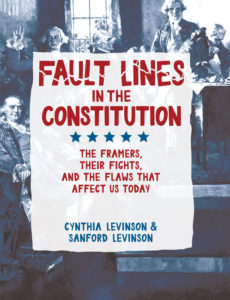 The 2016 Presidential election was the second in this century to feature a victorious candidate who came in second in the popular vote. Such a result has baffled observers from other countries, none of which have the same Electoral College system. How did such an unusual system come about, and what are some other features of the United States Constitution that over the centuries have become bugs?
The 2016 Presidential election was the second in this century to feature a victorious candidate who came in second in the popular vote. Such a result has baffled observers from other countries, none of which have the same Electoral College system. How did such an unusual system come about, and what are some other features of the United States Constitution that over the centuries have become bugs?
Acclaimed author for young people Cynthia Levinson and her husband Sanford Levinson, a noted Constitutional scholar, have co-authored a guide to the perplexed titled Fault Lines in the Constitution: The Framers, Their Fights, and the Flaws That Affect Us Today. This is an essential resource for readers, middle school and up, who are studying U.S. history and/or debating current political events.
The book is divided into six sections that address checks & balances, setting the boundaries of Congressional districts (and the infamous gerrymandering), qualifications for voters and elected officials, and provisions for emergencies. Each of the 20 chapters, with the exception of the final two, begins with a story highlighting a moment when the Constitution faced a crisis. For instance, was John McCain, born in 1936 in the Panama Canal Zone, a “natural-born” U.S. citizen, and would Ted Cruz, born in Canada to a U.S. citizen mother and a Cuban father, be considered one as well, had either been elected President? The authors provide the initial rationale for each of the contested provisions, how problems developed over the years, and how those problems were, or were not, addressed. The final two chapters “grade” the Constitution and how well it has aged and offer a debate between the two Levinsons on whether we need a new Constitutional Convention.
Throughout, the authors compare the U.S. Constitution, written in 1787 and amended 27 times (difficulty of amendment is one of the major themes here), with more recent constitutions in South Africa and elsewhere. They do an excellent job of highlighting the differences between a Presidential and a Parliamentary system and explaining why the Founding Fathers, distrustful of any government that placed too much power in one body, chose to separate the executive and legislative branches, and to set up a judicial branch to oversee both. Readers of Fault Lines in the Constitution will emerge with a greater understanding of why the framers of the Constitution made the choices that they did, and they, like the authors themselves, can debate whether such a structure is still viable today.
Because politics doesn’t stand still, and these ongoing debates have real consequences, the authors have set up a website to update the book post-publication and to address additional “fault lines” as they become apparent. To subscribe to these updates or simply read the latest, go to https://faultlinesintheconstitution.com/.
4 comments for “What’s Happening with the Constitution?”